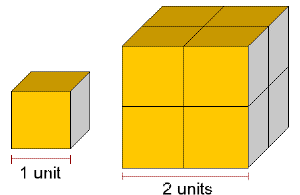|
 It
is interesting to compare the overall surface area of an object with
its volume. The volume increases disproportional to the surface area. The
increase in volume is greater than the corresponding increase in surface
area. Conversely, as an object becomes smaller, its surface area increases
when compared to its volume or weight. In living organisms, small cells have
a large surface area in comparison to their size, and this is crucial to their
existence. As cells increase in size the surface area decreases. This not
only relates to cells but applies to crystals and all other matter.
The increase in volume is always greater than the
increase in surface area. This is true for cubes, spheres, or any other object
whose size is increased without changing its shape. It
is interesting to compare the overall surface area of an object with
its volume. The volume increases disproportional to the surface area. The
increase in volume is greater than the corresponding increase in surface
area. Conversely, as an object becomes smaller, its surface area increases
when compared to its volume or weight. In living organisms, small cells have
a large surface area in comparison to their size, and this is crucial to their
existence. As cells increase in size the surface area decreases. This not
only relates to cells but applies to crystals and all other matter.
The increase in volume is always greater than the
increase in surface area. This is true for cubes, spheres, or any other object
whose size is increased without changing its shape.
Letís see if we can develop a surface area
(SA) to volume (V) (SA/V) ratio and compare them. We will use four different
cubes that you will make and then measure the edges and calculate surface area
and volume. We will plot the relationship of volume to surface area on a
graph then compare with another graph. The surface area of a cube can be
determined by length x width x 6 sides or SA (cube) = 6lw, but since length
= width in a cube, the formula is 6s2. The volume is just
multiplying length x width x height or volume (cube) = lwh. Since a cube has
all equal sides the formula for volume (v) = s3. |